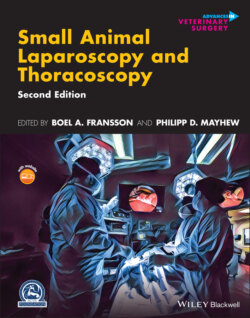Читать книгу Small Animal Laparoscopy and Thoracoscopy - Группа авторов - Страница 52
Barbed Suture
ОглавлениеTwo of the most difficult aspects of intracorporeal suturing are square knot formation and to maintain suture tension during continuous pattern suturing. The incorporation of barbed suture technology into MIS has made a significant impact in alleviating these difficulties (Figure 2.7). Barbed suture are knotless but also carries the advantage of multiple fixation points and tension distribution over the entire incision. The latter feature greatly enhances the strength of the repair [11]. In fact, even when cut at several sites, barbed suture can maintain the integrity of a closure [12]. Barbed suture technology has increased the number of clinical applications of intracorporeal suturing in small animal MIS (Figure 2.8).
Figure 2.8 A number of clinical applications have been facilitated by barbed suture. (A) cystopexy, (B) colopexy, (C) gastropexy, (D) peritoneal‐pericardial diaphragmatic herniorraphy.
Several barbed sutures (Quill™, V‐loc™, and Stratafix™ spiral; Table 2.1) are all produced by cutting into a parent strand of smooth suture. This is readily apparent when closely observing the suture strand (Figure 2.9). This manufacturing technique reduces the strength of the suture. Therefore, it is important that the surgeon understands the tensile strength of the particular suture used. Relative strength compared to the parent strand is presented in Table 2.1. To date, the most commonly used barbed suture in veterinary medicine is the V‐loc™ (Medtronics, Covidien, Mansfield, MA). The V‐Loc suture size is denominated in relation to strength compared to a smooth suture. Thus, a 3‐0 V‐Loc is cut from a 2‐0 parent strand, but strength corresponds to a smooth 3‐0 suture [13]. More recently, a barbed suture with a solid core has been made available (Stratafix symmetric, Ethicon Johnson & Johnson Medical Devices, Somerville, NJ) which circumvents the issue of production‐induced reduced tensile strength.
Table 2.1 Features of currently available barbed suture.
| Barbed suture tradename | Manufacturer | Barb density/cm | Barb directional | Barb orientation | Anchoring system | Smooth suture size strength equivalence of size 3‐0 barbedb |
|---|---|---|---|---|---|---|
| Quill | Angiotech Pharm. | 10 | Bia | Helical | N/A | 4‐0 |
| V‐Loc | Medtronics | 20 | Uni | Dual‐angle | Welded loop | 3‐0b |
| Stratafix spiral | Ethicon | No info | Bi | Helical | N/A | 4‐0 |
| Stratafix symmetric | Ethicon | No info | Uni | Opposing | Fixation tab | N/A. Produced with solid core |
a Bidirectional sutures do not have a separate feature for anchoring, as they have needles at both suture ends, and suturing starts in the center of the incision and continues in bilateral direction.
b Most barbed sutures are produced by cutting into a solid suture strand, rendering the barbed suture weaker than the parent strand. V‐Loc has size denominated by equivalent strength to smooth suture (i.e. a 3‐0 V‐Loc is as strong as a 3‐0 smooth suture), whereas others are keeping the size denomination of the parent strand. The surgeon needs to be aware of this as a 3‐0 barbed suture may only have the tensile strength of a 4‐0 smooth suture.
Figure 2.9 V‐Loc 90 (A) and Quill Monoderm (B) barbed suture materials. V‐Loc 180 sutures feature unidirectional dual‐angle barbs with a suture needle on one end and a terminal welded loop on the other. Quill Monoderm sutures are double armed and feature bidirectional, helical, single‐angle barbs that emanate from the center of the strand.
Source: Reproduced with permission from Zaruby [13].
